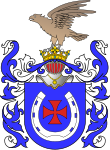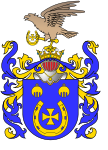|
Jastrzębiec coat of arms
Jastrzębiec (Polish pronunciation: [jaˈstʂɛmbjɛt͡s]) is one of the most ancient Polish coat of arms. Dating back to the 10th century, it has been used by Poland's oldest szlachta families — Poland's Immemorial nobility — and remains in use today. HistoryLegend of the coat of armsAccording to the Polish-Czech writer and heraldist Bartosz Paprocki, this coat of arms is called Jastrzebiec because the clan's pagan ancestors bore a Goshawk, or Jastrzab.[2] In the era of King Bolesław the Brave, circa 999, during a siege of the mountain fortress Łysa Góra – two miles from Bozecin, now called Swiety Krzyz (Holy Cross) – the Christian besiegers were challenged by the pagan holders of the place, to "Send forth one from among you who is willing to fight for Christ, in a challenge against one of our men." Jastrzebczyk, a knightly member of the Jastrzebiec clan invented horseshoes that enabled his horse to climb the slippery slopes and to defeat and bring the pagan champion before the king. The rest of the Polish forces, their horses similarly shod, scaled the mountain to defeated their enemy. In gratitude, king granted Jastrzebczyk the right to bear a horseshoe with a cross as part of his arms, with the Goshawk being elevated above the shield.[2] It is doubtful that Jastrzebczyk in 999, was the first in Poland to shoe horses. Poppaea, in the time of the Roman emperor Nero,[3] had her horse shod with silver shoes. Others before her used iron. In 278, in Bohemia, there was a noble house with three horseshoes on its seal.[4] In Poland, in the time of Leszek II, Leszek the Traitor shod his horse to cross Pradnik Field, which was covered in barbs, to get to a crown on a pillar,[5] and was credited as being the inventor of horseshoes.[6] It may therefore be that Jastrzebczyk renewed a previous practice. Possibly, the arms arrived in Poland with Lech, the legendary founder of Poland. The cross may have added for a member of his family who was baptized (in Stromata, Paprocki affirms that one member of this family while in foreign lands, converted to Christianity there, and this was the cause of the Polish prince Mieczyslaw's Mieszko conversion). The antiquity of the arms is further attested to by one of the Jastrzebczyks being among the twelve voivodes who at different times ruled the entire country.[2]  The antiquity of the Jastrzebiec coat-of-arms is also evident by the fact that no other coats of arms is borne by more families. Paprocki says, in O herbach, that several hundred years ago the clan called themselves simply Jastrzebczyks. Not until after the days of Archbishop Wojciech of Gniezno did foremost members of this house began to write z Rytwian ("from Rytwiany"). Other members similarly named themselves after the estates they possessed. Jastrezebiec's antiquity lead others coat-of-arms to be derived from it, including Dąbrowa, Zagłoba, and Pobóg. These arms are also called Boleszczyc, in Silesia, and Lazanki, in Mazovia. In other places Jastrzebczyks are called by names coming from the word for "goshawk", Kaniowa or Kudbrzowa. In Paprocki's day there was a Jastrzebiec castle, belonging to the Zborowskis; General Piotr Zborowski from Rytwiany, Kraków voivode, tore it down, dug it out, and had a large pond put in its place. Ancestors of this houseBased on a grant of privilege to a monastery in 999, Paprocki cites the most ancient member of this house as being a castellan of Sandomierz, a man named Mszczuj. Mszczuj's two sons Mszczuj and Jan, who signed themselves "from Jakuszewice", were both made canons in Kraków by Bishop Lambert in 1061. In 1084, Dlugosz wrote that the Jastrzebczyks who came from Hungary with Mieczyslaw, son of Boleslaw the Bold. Derszlaw was cup-bearer for King Bolesław Wry-mouth in 1114. Bolesław IV the Curly granted the title to the villages of Jakuszewice and Kobelniki to Derszlaw's sons Wojciech and Derszlaw, of whom Wojciech was the Sandomierz standard-bearer. Paprocki cites a fragment of his in O herbach, but the long stretch of time between them and their father, 166 years, indicates that they were not the sons of Derszlaw the cup-bearer. Paprocki cites a monastery grant of privilege given in 1199 for Borzywoj and Derszlaw Jastrzebczyk, heirs to Jakuszowice. He also includes Piotr, son of Wojciech, the Sandomierz standard-bearer. Swentoslaw, a pastor from Poznań and Gniezno canon, was chosen to be bishop of Poznań; already of an advanced age, he had retired, but he yielded to those urging him and accepted the office. He spent only a year at this see before his death in 1176 and was buried in the church. Nakiel. w Miechov. fol. 66, praises the good works of this Swietoslaw, for saving his monastery at its beginning with generous alms; he ascribes to Swietoslaw the Pobog arms. Yet Długosz in Vitae Episc. Posnan, and others, call him a Jastrebczyk. Paprocki writes that in Jędrzejów a grave from the year 1206 is covered with a stone on which the Jastrzębiec arms are still visible, but the letters can no longer be read. Piotr Brevis (called Maly ("small"), as brevis is Latin for "short") was chosen to be the nineteenth bishop of Plock in 1254. In the fifth year of his episcopate, he moved to another see. However in Vitae Episc. Plocens, Lubienski ascribed no coat-of-arms to him yet wrote Piotr Brevis was of a noble clan. Paprocki in O herbach, added that Piotr Brevis was a Jastrzebczyk. Silesian Bishop Jan of Wrocław was the first Pole to ascend the episcopacy, inasmuch as only Italians had held the position before. Bishop Jan of Wrocław elected in 1062, presided for 10 years, and died in 1072. This is attested to by Dlugosz in Kronika, wherein he wrote that Bishop Jan of Wrocław was of the Jastrzebiec clan.  Additional forebears of this clan are Michal, castellan of Kraków in 1225; Mistuj, voivode of Kraków in 1242; Scibor, voivode of Leczyca in 1242; and Msciug, voivode of Sandomierz in 1342. A letter of Kazimierz the Great, King of Poland, given to the Strzelno monastery, mentions, inter praesentes, Mszczuj, Kraków chamberlain. Jedrzej, Bishop of Vilna, called "Vasilo" by the Lithuanians, was an apostolic shepherd in the days of King Władysław II Jagiełło. Kromer. In 1399, Jedrzej proselytized Christianity in pagan Lithuania. Marcisz, brother of Bishop Jedrzej, endowed the Franciscan Fathers in Nowe Miasto with a monastery and he bought Zborów, from which came the family of Zborowskis. Wojciech, Archbishop of Gniezno, was born in the village of Lubnica. His father, possessed of a meager fortune, gave up Wojciech to the Bensowa parish church. As Dlugosz wrote n Vitae Episcop. Posnan.:
Wojciech listened to all of this and promised to fulfill the exhortation as a paternal order. The hopes of both were realized, for Wojciech, soon became a priest, from being a Kraków scholastic, as Dlugosz says, or from being a Kraków dean and Poznan pastor, he became the mitred prelate of Poznan in 1399. Tearing down the wooden church in Bensowa, he had a brick one built in 1407, and later settled the friars of St. Paul the Hermit there, and gave to it the villages of Bensowa, Bensowka, Bydlowa, and Bystronowice. Besides this, he founded the collegiate church in Warsaw, and the cathedral. Thus for 14 years Wojciech held that post at that church in a laudable manner, so that he was held in high regard by all, both for his wisdom, which was demonstrated at every chancellery function, and for his piety. But he put himself under great strain when, having removed Piotr Wiss, of Leszczyc arms, from the Kraków episcopacy. He recalled Wiss to that of Poznan and he himself occupied the Kraków bishopric in 1412. He had many quarrels because of it: for as soon as the matter arose at the Council of Konstanz it moved all the priests assembled there with compassion for Peter Wiss, and surely Wiss would have returned to his bishopric if he had not died at that point. Wojciech, more secure after Wiss's death, founded a city, having cleared some woods, and called it Jastrzebie. He endowed and gave to it two parish churches in Sandomierz province: one in Wysokie, in Lublin district; the other in Kortynicak, in Sandomierz district. He designated a tithe for the altar of St. Agnes, in Kraków diocese. Then in 1423, he was elevated to the rank of metropolitan and primate, and there left a memory of his generosity, funding two benefices, one theological and one juridical, as well as a third in Kalisz. He set up an altar in Leczyca, returned regular canons to Klodawa, and raised their church to collegiate rank. He died in 1436, an important, judicious man and a great lover of his country, as Dlugosz and Damalew praised him in Vitae Archiepisc. Gnesn., and Starowol. in Vitae Episc. Cracov. Wojciech had amassed considerable wealth, which he left to his successors, and while yet alive bought for them Rytwiany, in Sandomierz district, and Borzyslawice, in Leczyca district, where he funded benefices. The sources of that wealth were suspect, in that the curate of the Poznań Cathedral had shown him the collection and treasury of the ancient kings of Poland, of which the curates had passed on knowledge in secret, each to the next, until that time. From that time, Wojciech's successors began to sign their names as z Rytwian ("from Rytwiany"): his brother was Scibor, voivode of Leczyca, who had twenty sons. Paprocki saw all their portraits in the Bensowa church, but the signatures under them could not be read. Eight of the sons died in the Prussian war, the other twelve were various castellans.[2] In the Jastrzębiec family, there is also the case of a man from the Witowski family, who, on the basis of his marriage, left for Russia, from where, in the next generation, a high-ranking aristocrat Katarina Wiltawsky returned to the vicinity of Krakow, who married a Polish German (Pruska), who took her surnames and Russian titles of nobility. Their descendant Baron Wiltawský attended the coronation of Emperor Charles VI. in Prague. The descendants of this line remained settled in the vicinity of Ratibórz and Opava.[7] Books: Crönungs - Ceremoniel , Oder Accurate Nachricht , was Bey der Crönung Des Aller Blazon The following is from the classic heraldic reference Herbarz Polski, by Kasper Niesiecki, S. J., Leipzig edition, 1839-1846. In this book, for each herb (clan shield or coat of arms) the blazon, or verbal description of the arms, is first given in authentic heraldic style, followed by a translation from the Polish description by Niesiecki.
In heraldry, the right and left sides of a shield are considered from the standpoint of the bearer—i. e., the one holding the shield. His right would be your left and vice versa. The tinctures (colors) are as follows: azure = blue; gules = red; sable = black; or = gold; argent = silver; and vert = green. All charges (pictures) on a shield are assumed to be facing dexter (bearer's right side) unless otherwise specified. In Polish heraldry, all animals or birds are assumed to be in their natural coloring unless otherwise specified. Notable bearers
• Jan Lutomirski
Towns and countiesGalleryStandard variations
Aristocratic variations
See alsoRelated coats of armsSourcesReferences
External links
|
||||||||||||||||






























































